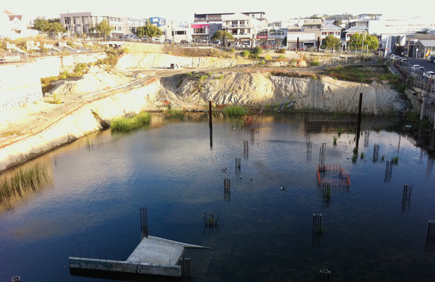Very, very excited by my new favourite animal in the garden – check him out: a juvenile and rather pretty green and golden bell frog who I found hiding under the cucumber vine, keeping out of the hot midday sun like the sensible Aussie immigrant he is.
Finding a frog under the vine was a timely reminder of why it’s important – but not easy – to be green. We have pretensions to being organic (and biodynamic) in our little patch of garden, but have been sorely tested lately by an incredible infestation of passion vine hoppers, plus an attack by downy mildew on all our broad-leafed plants (pumpkin and cucumber especially) – which have been rotting before our eyes.
The vine hoppers we’ve been forced to constantly spray with pyrethrum – which works, but kills lots of other insects too – and the downy mildew I’d just dosed a day earlier with a liberal spray of copper solution.
Now, okay, both those treatments fall under the vague umbrella of being organic, but only the deluded would deny that they’re both potent, concentrated chemicals – a fact that I was reminded of when I turned up a leaf on the cucumber vine and copped a mournful, slightly judgemental stare from froggy.
Frogs, as most people know are super-susceptible to environmental poisons. They’re able to conduct limited gas exchange through their skins – ie, they can breath through their skin – which means their whole body surface, just like the inside of your lungs, needs to be wet and permeable.
But think about how easy it is for you to get a chest cold – or how quickly cigarette smoke gets into your bloodstream through your lungs – that’s the level of vulnerability frogs deal with across their whole body – they very readily soak up insecticides, chemicals and fungal infections – and frog populations across the world are plummeting because of it.
Except for our pal the green and golden bell frog here. Back home in Oz, sure, they’re becoming endangered, but I was happy to read that in NZ they’re considered a not-at-risk feral species, and that they even thrive in disturbed, industrial areas where ponds form.
Ponds? Industrial areas? So you know what I’m thinking! Frogs in the Ponsonby Sohole!
Yep – I’m TOTALLY building a mini frog pond in my garden – check out the wine barrel I’ve already sawed in half – and I’m TOTALLY seeding the Sohole with my first batch of frogs.
The only problem will be getting them down there. The Sohole is heavily fenced off, and the drop into the water is about three to four stories deep. I could simply throw the frogs in, but I’m thinking the fall could kill them. I’m trying to remember my fifth form science here…
I do know that good old Galileo Galile dropped different sized stones off the Leaning Tower of Pisa and proved that the mass of an object doesn’t affect the speed at which it falls – but I’m sure that mass becomes relevant when you hit the ground (or hard, flat water). It’s like the question ‘would you rather be hit by a bike doing 50 kph, or a truck at the same speed?’ – you definitely want to choose the bike, as its lower mass imparts less energy.
Equally, if you tossed a person four stories into the Sohole, they’d be likely to splat when they hit the bottom; something as small as a tadpole would proabably only get a headache. But a frog, with its slightly greater mass, might still – I’m sorry! – croak .
Yeah, that’s one deep hole. So what we clearly need is a device for getting the frogs down. Rebecca thinks we should be lowering them down on fishing rods, in little latch-released cages at the end of the line. Me, I’m tending to the more ambitious frog-a-pault and parachute option (obviously the parachute is tied to the frog with soluble string – duh) – but what do you think? Answers on the back of an envelope please – the less practical the better.





The practical option is lowering them down in a bucket by rope. Easy.
But a fun option could be building them a froggy hydro-slide…